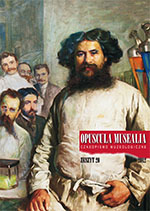Problem przedstawienia wizerunków zwierzęcych w dziełach rzemiosła artystycznego na przykładzie kałamarza ze zbiorów MUJ
Problem of animal representations in applied art on the example of an inkwell from the Jagellonian University Museum’s Collection
Author(s): Małgorzata Taborska, Beata FrontczakSubject(s): Fine Arts / Performing Arts
Published by: Wydawnictwo Uniwersytetu Jagiellońskiego
Keywords: Viennese bronze figurines; Bermann manufactory; inkwell; garden spider
Summary/Abstract: A 19th-century inkwell in the form of a cross spider which can be found in the Jagiellonian University collection represents a large group of Viennese bronze figurines. It was probably manufactured at Franz Bergmann’s shop in Vienna in 1894. In the same year it was bought by Zygmunt Pusłowski in Kraków, most likely at Wilhelm Fenz’s shop (Skład Towarów Galanteryjnych). The inkwell was cast, then chasing and painting were applied, faithfully rendering the specimen’s morphology detail. Despite some anatomic inaccuracies, one can identify the species, sex and age of the original specimen. It can be assumed that the workshop marketed a series of inkwells in the form of spiders. A similar inkwell which has survived in a private collection, features a naturalistically rendered spider with the inkwell container hidden in its abdomen – in this case it is a Theridiidae (tangle-web) spider. The same anatomical errors may be found in both items, but in both cases a similar care for detail, also in taxonomic terms, is shown. Interestingly, the artist has chosen both specimens belonging to synanthropic species which people can see around. While the garden spider was modelled after a live spider during its everyday occupations, the representative of the Steatoda was dead. It was probably found somewhere in the cellar or a cubbyhole. The figurines were made using the lost-wax casting technique, using a plaster mould, thanks to which precision in rendering detail was possible. The manufacturer faithfully rendered tiny details of the model, but its size was enlarged nearly 1000 times. The items are of interest in the cultural context as well – the spider motif has a symbolic meaning which may be retraced back to the ancient era and which was evolving until the late-19th-century symbolism.
Journal: Opuscula Musealia
- Issue Year: 2012
- Issue No: 20
- Page Range: 45-61
- Page Count: 17
- Language: Polish

